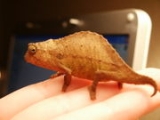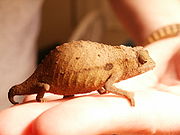
Rieppeleon brevicaudatus
Encyclopedia

Chameleon
Chameleons are a distinctive and highly specialized clade of lizards. They are distinguished by their parrot-like zygodactylous feet, their separately mobile and stereoscopic eyes, their very long, highly modified, and rapidly extrudable tongues, their swaying gait, the possession by many of a...
originating from the eastern Usambara
Usambara Mountains
The Usambara Mountains are a mountain range in North-East Tanzania, approximately long and ranging from 20 to in width. Mountains in the range rise as high as 8,000 ft ....
and Uluguru mountains in northeastern Tanzania
Tanzania
The United Republic of Tanzania is a country in East Africa bordered by Kenya and Uganda to the north, Rwanda, Burundi, and the Democratic Republic of the Congo to the west, and Zambia, Malawi, and Mozambique to the south. The country's eastern borders lie on the Indian Ocean.Tanzania is a state...
. It is easily distinguished from others in the Rieppeleon
Rieppeleon
Rieppeleon is a genus of small, typically brown chameleons found in forests and savannas in central East Africa...
genus
Genus
In biology, a genus is a low-level taxonomic rank used in the biological classification of living and fossil organisms, which is an example of definition by genus and differentia...
by the presence of a "beard" below the mouth, consisting of a few raised scales. At a full grown length of only a few inches (~3" or 8cm), it is marked by somewhat drab coloring in comparison to other chameleons, usually assuming a brown or tan coloring. It is quite capable of changing its coloration though, often taking on a shade to blend into the background and becoming darker when under stress. It is also capable of compressing its body laterally and producing a stripe down its side, mimicking a dead leaf. It often assumes this form when sleeping in the open. It can adopt a variety of colors including yellow, green, orange, black, and brown. A common misconception is that these chameleons use their color changing abilities as camouflage, but they actually use their color changing skin to court, and show stress or emotion. As the chameleons are not known to be poisonous, they are also thought to use vibrant colors in an attempt to intimidate potential predators. Males are distinguished by a longer tail, more prominent dorsal crest, slimmer body type, and persistent patterning. Like others in the Chamaeleonidae family, it is distinguished by independently rotating eye sockets and a tongue longer than its body.
Captive care
R. brevicaudatus prefers a temperature between 70 and 80°F with a slight drop at night. It is unknown if they utilize UV light, and many keepers report success with simple halogenHalogen
The halogens or halogen elements are a series of nonmetal elements from Group 17 IUPAC Style of the periodic table, comprising fluorine , chlorine , bromine , iodine , and astatine...
or fluorescent lighting. Basking lights may be provided but are generally not necessary, and care must be taken to keep the temperature down. Being quite small, a five to ten-gallon glass aquarium
Aquarium
An aquarium is a vivarium consisting of at least one transparent side in which water-dwelling plants or animals are kept. Fishkeepers use aquaria to keep fish, invertebrates, amphibians, marine mammals, turtles, and aquatic plants...
can be used. Regular misting at least twice a day is required, with direct misting of the chameleon recommended. R. brevicaudatus feeds on small insects; in captivity they are partial to cricket
Cricket (insect)
Crickets, family Gryllidae , are insects somewhat related to grasshoppers, and more closely related to katydids or bush crickets . They have somewhat flattened bodies and long antennae. There are about 900 species of crickets...
s, wax worms/moths
Moths
Moths may refer to:* Gustav Moths , German rower* The Moths!, an English indie rock band* MOTHS, members of the Memorable Order of Tin Hats...
, houseflies, and others. Though considered fairly hardy, care must be taken to prevent stress, as with other chameleons. Lifespan is generally several years. They do need a dripper system, a 10-gallon or bigger aquarium, and live plants.
Unlike most chameleons, R. brevicaudatus are social; pairs can be housed in 10–15-gallon tanks and trios of one male to two females can be kept in 20-gallon tanks. Isopods and springtails are good additions to any vivarium, cleaning decaying material, fungus, and mold, and providing a food source; however these should not be substituted for a normal, healthy diet of other insects. Females will dig in the soil to lay their eggs and unlike most chameleons the eggs will do fine until they hatch right where they were laid in the terrarium.

